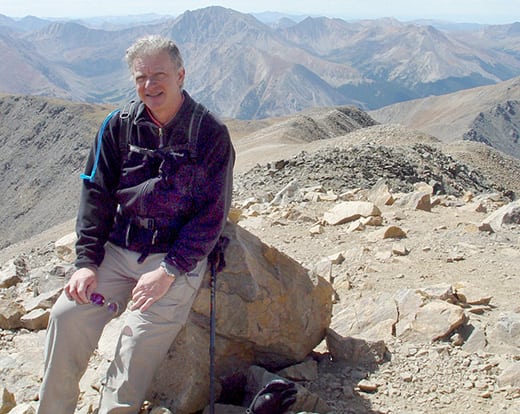
Mt. Elbert is distinguished as the highest peak in Colorado and the second highest in the lower 49 states, only Mt. Whitney in California is higher by 65 feet. This mountain also is distinguished as the first for those who go on to climb other Colorado fourteeners. Indeed it was my first in the summer of 2002, three years after I moved to Colorado.
Located in the Sawatch Range of the Colorado Rockies, Mt. Elbert was named for Samuel Elbert who was a controversial territorial governor of Colorado in 1873. Aside from the elevation gain which is substantial at 4700’ and the obvious elevation of its summit, far above 14,000’, Elbert is an easy “walk up” graded Class 1, with a well-defined path the whole way up.
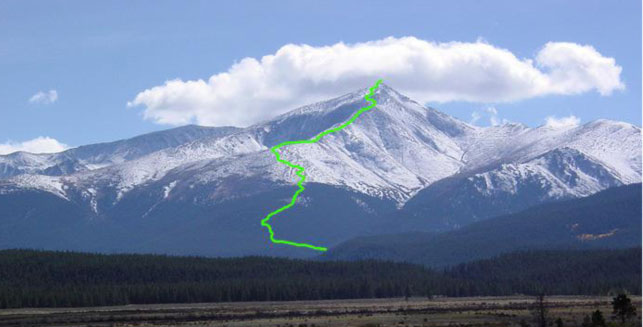
Most of the Northeast Ridge route up Mt. Elbert is shown here from US 24 near Leadville.
The route has a fairly steady uphill profile except for a small bit of descent after a false summit at about 14,000’

We left Aspen early, drove over Independence Pass and started hiking from trailhead at 6:30 am.
Our weather was good with the summer monsoons having subsided as they often do by the end of August.
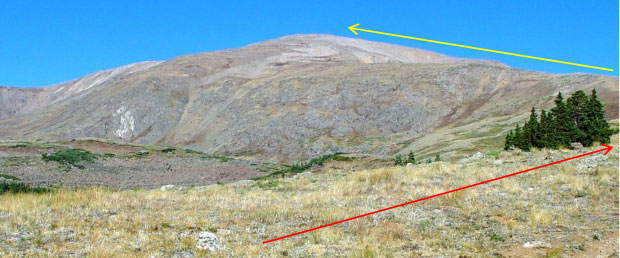
A closer look at Elbert’s Northeast ridge and the route from tree line at about 11,700’
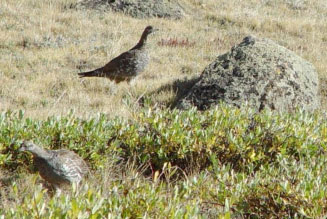
Almost perfectly disguised with surrounding rock colors, the White-tailed Ptarmigan follows our progress without much fear. They prefer to run along the ground, although they can take flight.
This is the alpine species and is the only bird to permanently reside in the alpine zone – rocky, snowy meadows.
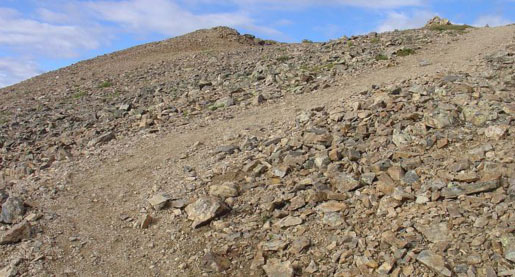
Nearing 14,200’ with the summit in sight.
Summit : Mt. Elbert 14,440’
11:45am, 5hrs 15 min from trailhead.
La Plata, another fourteener, in the background – it would be another 7 or 8 years before I would go for that one … and a bunch more.
I actually stood on the rock to get even a bit taller. I was so impacted by doing something like this that I’ve never done before, even though it was only a “walk-up” that I got all teary-eyed and thought, well maybe I can do some others, although for some reason it took me several years to really get going on these.
This is a recapture of a few old photos – and I don’t have any of Shan on that hike.
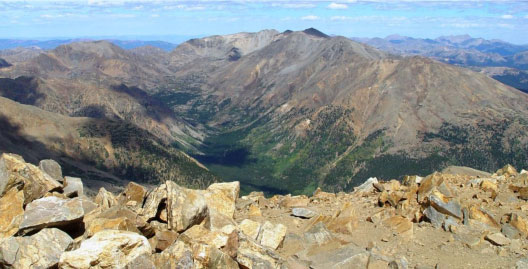
Some views from the summit- looking north to Mt. Massive, another fourteener topping at 14,428’. Some tried piling rocks on its summit to claim the tallest in Colorado, but others tore it down as not natural – so Elbert still holds the title.
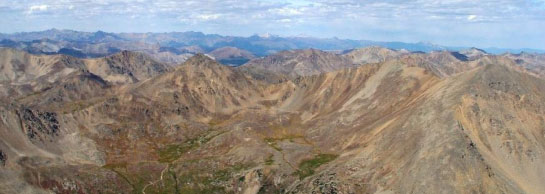
View west towards the famous Elk Range – Capitol, Pyramid, Maroon Bells, Sopris …
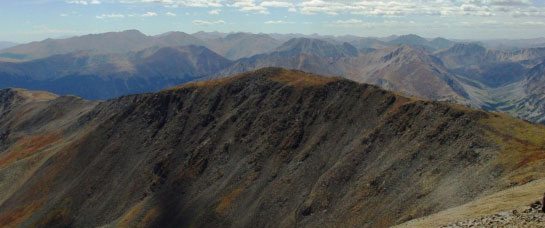
View towards Denver – Pikes Peak, Grays and Torreys and a bunch of other 14ers.
It is not well known that all of Colorado’s fourteeners (and Denver itself as well as other high points of interest in the West) were recalibrated with modern techniques in 2002 and the result was almost all elevations being upgraded by about 6 or 7’. Here’s an article in the Denver Post describing the result:
No Tall Tale: State Higher than Thought
By Steve Lipsher
Denver Post Staff Writer
Sunday, July 07, 2002 –
“Mile High City” actually comes up a little short in describing Denver.
And the state’s highest peaks appear to have risen, too, after the federal government quietly refigured the state’s elevations. Reflecting cartographic accuracy more than geologic uplifting, the latest maps from the U.S. Geological Survey set the official heights of many Colorado landmarks as much as 7 feet higher than before.
“You always think of elevations as things that are precisely known and don’t change over time,” said Jack Reed, a USGS geologist based in Golden. “But these things are always being revised.”
According to the new calibration, the marker on the 15th step of the state Capitol – bearing the words “One Mile Above Sea Level” – actually is about 3 feet off. People at the Capitol were puzzled as to whether the recalculations would mean moving the brass marker on the west steps. That’s because the step etched “One Mile Above Sea Level” was determined to be inaccurate in 1969, and a round brass marker was installed four steps higher showing the “real” mile high.
Dan Hopkins, spokesman for Gov. Bill Owens, said the Colorado Historical Society would have to get involved if new mile-high calculations were made necessary by the recalculations. “What about the row of purple seats at Coors Field?” Hopkins asked, referring to the 20th row in the upper deck marking the place where the Rockies baseball stadium reaches 1 mile above the sea. “Does it have to be moved? That’s got to be more complicated than moving a marker on the steps. The row of seats is pretty long.
Mile still measures it
To be certain, many points within Denver city limits still can be found at exactly 5,280 feet above sea level, so the folks at the City and County Building don’t need to get in a tizzy over creating a new moniker. And, because they’re more or less uniformly applied, the new elevations actually don’t change the rankings of any of the state’s 54 14,000-foot peaks, nor does the state claim any additions to the list. Grizzly Peak near Independence Pass, formerly listed at 13,988 feet, still falls short of the threshold at 12,995’ now.
Colorado’s highest point, Mount Elbert near Leadville, gained 7 feet to a lofty 14,440 feet above sea level. And Pikes Peak – an internationally renowned landmark long considered to be 14,110 feet – now is listed at 14,115.
But prominent mountaineer and guidebook author Gerry Roach points out that four new peaks have been added to the list of thirteeners. “That’s exciting,” he said, noting that a small but growing list of people, including his wife, Jennifer, had thought they’d climbed all of the peaks above 13,000 feet. Still, he dreads the work ahead of him in revising his books, “Colorado Fourteeners” and “Colorado Thirteeners.” “If every altitude of every peak changed, that’s a nontrivial editing job,” Roach said. “It will change practically every page in the book.”
West’s landscape altered
The official revisions actually came about a couple of years ago when Congress formally adopted the National Geodetic Vertical Datum of 1988, but they are showing up on maps only now due to slow bureaucracy.
Armed with thousands of benchmarks created since the last comprehensive survey in 1929, the number-crunchers at the National Geodetic Survey recalculated the “geoid,” an imaginary surface that represents sea level, hammering out discrepancies that indicated, for example, the Pacific Ocean being higher than the Atlantic.
The biggest changes were found in the West, where mountain peaks have been imprecisely measured since the days of the Hayden Survey in the 19th century. But in all, the latest revisions reflect relatively minor changes even from the calculations of the original surveyors, who did a remarkably good job relying on now-archaic processes such as triangulation.
You can get elevation details for specific locations by going to the National Geodetic Survey Web site,http://www.ngs.noaa.gov/cgi-bin/ds_radius.prl. You need to supply approximate longitude and latitude and a radius bot get a list of benchmarks in the area you specified.



